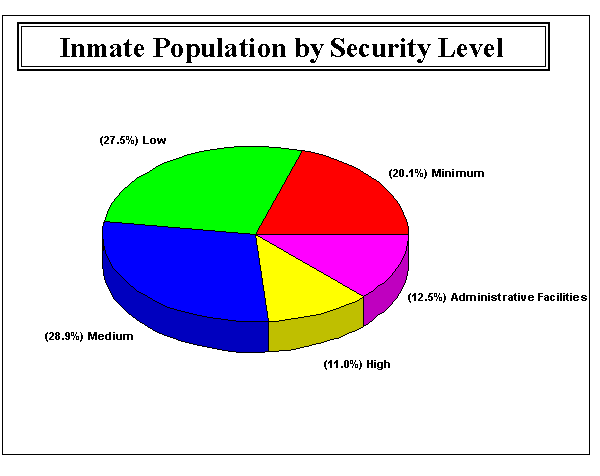
MISSION STATEMENT
The Federal Bureau of Prisons protects society by confining offenders in the
controlled environments of prisons and community-based facilities that are safe, humane,
and appropriately secure, and which provide work and other self-improvement opportunities
to assist offenders in becoming law-abiding citizens.
FEDERAL PRISON SYSTEM COMPONENTS AND ORGANIZATIONAL STRUCTURE
The Federal Prison System (FPS) encompasses the appropriated activities of the Bureau of Prisons (Bureau) and its functional entities, Federal Prison Industries, Incorporated (FPI), also known by the trade name UNICOR, and the Commissary Trust Fund (Commissary).
As of September 30, 1996, the Bureau of Prisons was comprised of 86 institutions, six regional offices, three training centers, and a central office or headquarters in Washington, D.C. The Executive Office of the Director provides overall direction for agency operations, with nine central office divisions, each led by a member of the Bureau's Executive Staff, which provide operational and policy direction. The central office manages the security and correctional operations of the Bureau, the medical and psychiatric programs, and food and nutritional programs. Additionally, the central office plans for the acquisition, construction, and staffing of new facilities, and oversees the Bureau's budget development and execution, contracting, property management, and financial management. Additional operational support and direction is provided for community corrections and detention programs, legal counsel, public affairs, information resources, and human resources management. Program oversight is performed through a rigorous program review process which measures program effectiveness and adequacy of internal controls.
The National Institute of Corrections (NIC), formerly a separate budget entity but now a Salaries and Expenses funded operation of the central office, provides technical assistance and training for state and local correctional agencies across the nation. NIC supports the Bureau's goal of building partnerships with community, state, local, and other entities.
The Bureau is subdivided into six geographical regions (see Attachment A), each led by a Regional Director. Regions are staffed with personnel who provide operational guidance and support to the field locations in such areas as financial management, budgeting, auditing, technical assistance, personnel, and correctional management.
In FY 1996 the Bureau operated 86 institutions spanning five main security levels in its efforts to provide secure and cost effective housing to a broad spectrum of offenders. Minimum Security institutions are work and program oriented, with low staff-to-inmate ratios and no fences. Low Security Federal Correctional Institutions (FCIs) are work and program oriented, normally dormitory structured, and have double fenced perimeters. Medium Security FCIs have strengthened perimeters, often double fenced with electronic detection systems, cell-type housing, with work and treatment programs, and higher staff-to-inmate ratios. High-Security institutions, also known as United States Penitentiaries (USPs), are highly secured facilities with close supervision and monitoring of inmates. Finally, Administrative facilities are institutions with special missions, such as the detention of noncitizen or pretrial offenders, treatment of inmates with serious or chronic medical problems, and the containment of extremely violent or dangerous inmates. Administrative facilities are capable of housing inmates of all security categories.

Federal Prison Industries (FPI) is a wholly-owned government corporation created by the Congress in 1934. FPI's mission is to provide employment and training opportunities to inmates confined in federal correctional facilities and to provide market-priced, quality products and services to other federal agencies. FPI conducts its operations in a self-sustaining manner which minimizes competition with private industry and labor while providing inmates with occupational knowledge and skills. As FPI is a self-sustaining corporation, appropriated funding is generally not provided for FPI operations; however, some appropriated funds are used for factory construction. FPI operations currently focus in five areas: Textiles; Electronics; Furniture; Metals; and Graphics and Services.
The Commissary Trust Fund was created in the early 1930's to provide a means for inmates to purchase additional products and services above those provided by federal funds, e.g. personal grooming products, stamps, and telephone services. The Trust Fund is a self-sustaining revolving account which is funded through sales of goods and services to inmates.
FISCAL YEAR 1996 BUDGETARY RESOURCES
During fiscal year 1996 the Federal Bureau of Prisons had three appropriations: an annual appropriation for Salaries and Expenses; a Buildings and Facilities appropriation; and, for the first time, an appropriation for its Violent Crime Reduction Programs (VCRP). The Building & Facilities and VCRP are no-year appropriations. Additional resources are obtained through sales of goods and services provided by the Commissary and FPI.
The Salaries and Expenses (S&E) appropriation is used to provide for the care and custody of all federal offenders, whether in federal institutions or contract facilities, and to maintain and operate all federal facilities, regional offices, staff training centers, and the central office. Funding is divided into four mission programs:
- Inmate Care and Programs
- Institution Security and Administration
- Contract Confinement
- Management and Administration
In Fiscal Year 1996, the Salaries and Expenses annual appropriation had budget authority of $2,564,159,000. Additionally, $55.5 million in S&E funds were available in carryover and multi-year funds. Of the FY 1996 S&E appropriation, funds totaling $32,586,000 were transferred to the Department of Health and Human Services for inmate medical care.
$1,587,211,928 of the funds provided for the S&E appropriation were used for salary expenses, with the balance of $830,065,022 being used for operating expenses.
The Buildings and Facilities (B&F) appropriation is a no-year appropriation which supports site planning, acquisition and construction of new facilities, and the remodeling, repairing, and equipping of facilities for penal and correctional use. In fiscal year 1996, the B&F appropriation had just over $1.1 billion in available funds, broken out as follows:
$382,830,881 of the funds provided for the B&F appropriation were used for construction (building and facility) expenses, with the balance of $17,563,713 being used for salary expenses.
A no-year appropriation for VCRP was established in fiscal year 1996 for expenses associated with the Bureau of Prisons' comprehensive drug abuse treatment programs. A total of $13,500,000, less a $16,000 rescission, was provided through the Violent Crime Reduction Trust Fund, as authorized by Section 32001 (e) of Public Law 103-322.
$5,702,248 of the funds provided for the VCRP were used for salary expenses, with the balance of $12,400 being used for operating expenses.
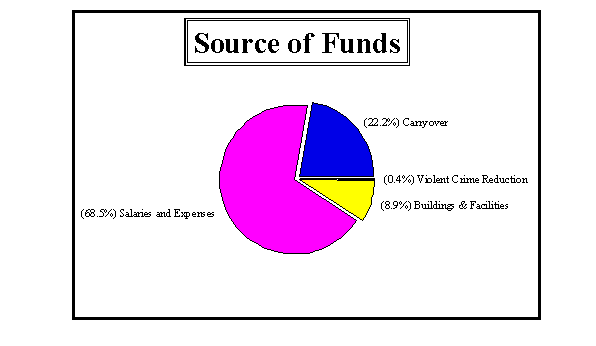
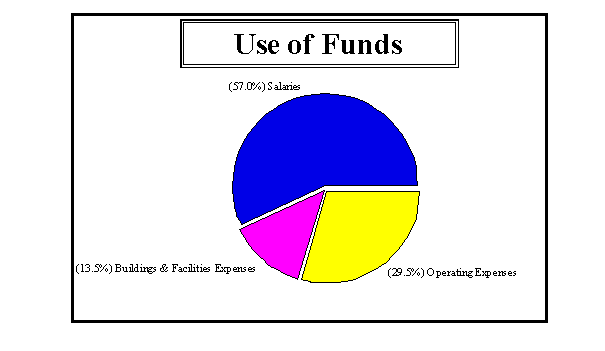
Federal Prison Industries, Inc. is a self-sustaining government corporation which does not require appropriations of tax dollars for its operations. Revenues, excluding investment income, are derived entirely from the sale of products and services to other federal agencies. Amounts used by FPI for administrative expenses are subject to Congressional limitation. The limitation in FY 1996 was $3.6 million; however, expenses incurred by FPI were only $1.8 million.
FPI's FY 1996 sales exceeded planned goals by 8.6 percent or $39.1 million, totaling nearly $495.51 million. Earnings exceeded planned goals by 14.2 percent, or $1.5 million, for total earnings of $12.1 million. Credit card sales grew significantly, from $1.5 million in FY 1995 to $7.0 million in FY 1996, providing both sales and cash flow benefits. Future growth of credit card sales at a similarly rapid rate is expected over the next few years.
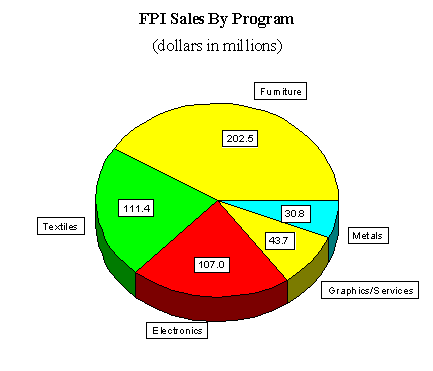
During fiscal year 1996, the Commissary Trust Fund operated in accordance with
revenues generated from sales of merchandise and telephone service to inmates, as the
following table demonstrates:
| Source of Revenue | Total Amount | Percentage of Total Revenue | Return on Sales |
| Sale of Merchandise | $93,400,000 | 63.00% | 0.68% |
| Inmate Telephone System | $49,300,000 | 33.20% | 29.86% |
| Vending Operations | $3,600,000 | 2.40% | 45.81% |
| Interest Income | $2,100,000 | 1.40% | N/A |
| TOTAL | $148,400,000 | 100.00% | N/A |
Since 1995 the Trust Fund, in accordance with Public Law 103-317, has the authority to
invest funds in excess of operating needs in securities guaranteed by the United States
Treasury. Trust Fund investments were between $40 and $50 million in FY 1996, with
interest earnings of approximately $2.1 million. Interest earnings were used to defray
current operating expenses.
FEDERAL PRISON SYSTEM PERFORMANCE GOALS AND ACCOMPLISHMENTS
Population Management: The Bureau will proactively manage its offender population to ensure safe and secure operations.
At the end of FY 1996, the Bureau had an inmate population of 105,432, including 94,695inmates in Bureau facilities and 10,737 in contract facilities. The Bureau managed this population with a system capacity of 76,442, representing a crowding level of 124 percent. Effective population management is also being challenged by the increasing number of convictions and increasing length of sentences for many crimes.
During 1996, 89 percent of all violent criminals who were convicted received prison sentences, with 102 violent criminals sentenced to life. This year marked a substantial rise in the length of prison sentences for defendants convicted of criminal civil rights violations. In racially motivated cases, sentences more than doubled last year's total, 3,908 months plus three life sentences, compared to 1,917 months.
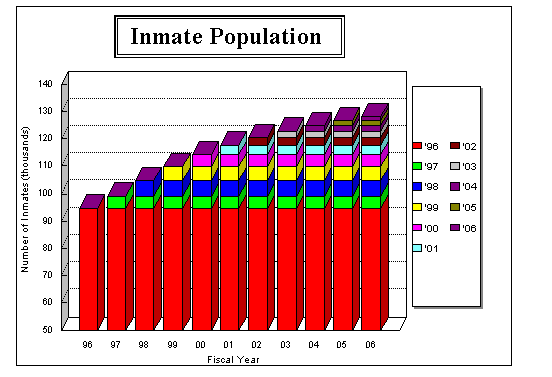
Note: 1996 figures are actual and 1997 through 2006 are projected.
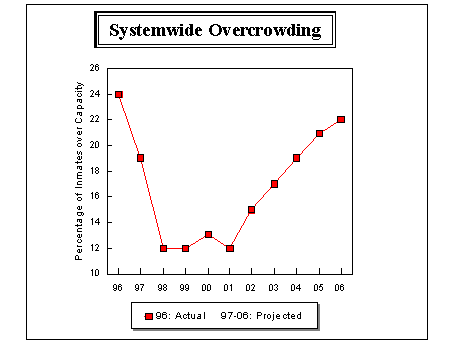
Inmate Programs: The Bureau provides services and programs to address inmate needs, providing productive use-of-time activities, and facilitating the successful reintegration of inmates into society consistent with community expectations and standards.
Approximately 30 percent of the Bureau's sentenced inmate population are "drug dependent" and require some type of drug abuse treatment program. In addition, 12,828 inmates participated in the Bureau's extended Residential Substance Abuse Treatment Program during FY 1996. The Bureau's Drug Abuse Treatment Programs address the needs of these inmates through a comprehensive institution and community-based treatment structure.
The Bureau's Community Correction Centers and home confinement programs grew to approximately 6,200 inmates in FY 1996. Over 70 percent of all the Bureau's releases, nearly 18,000 offenders, went through community-based transitional programs, with approximately 89 percent successfully completing the programs. Most offenders who fail community-based transitional programs are returned to prison.
Equally important to the Bureau's Inmate Programs, is ensuring inmate responsibility
for debts and fines. During FY 1996, over $5.1 million was collected and disbursed through
the Inmate Financial Responsibility Program (IFRP). The majority of all disbursements made
for IFRP went to victims assistance and support groups or as direct compensation to
victims for losses resulting from crimes.
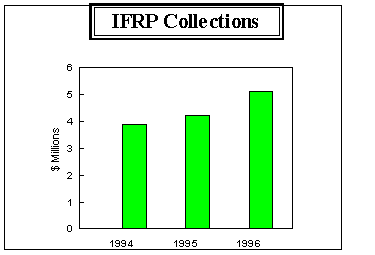
Federal Prison Industries significantly contributes to the Bureau's effective
management of inmates and towards the Bureau's goal of vocational training and educational
opportunities for inmates. Inmates employed at FPI factories at fiscal year-end numbered
17,379, up from 16,780 in FY 1995. Managerially, FPI not only increased its sales and
exceeded its plan by $39.1 million, it did so in a year in which it reduced inventory
levels and accounts receivables. In addition, during FY 1996 FPI factories were opened at
Coleman, Florida and Beckley, West Virginia.
In order to continue to be self-supporting, the Commissary Trust Fund's goal is to
maintain a gross profit (sales minus cost of goods sold) percentage of 20 percent on
Commissary sales. Each institution is monitored quarterly to assure the gross profit
expectations are achieved.
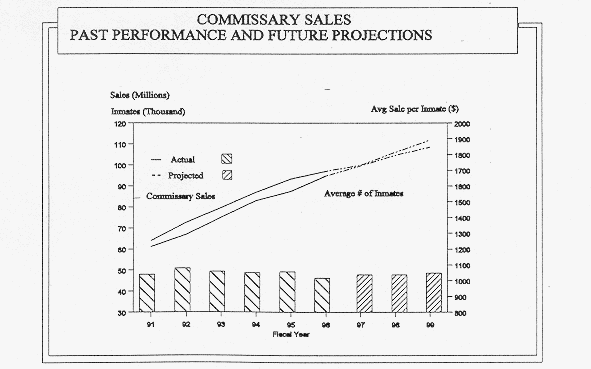
The following is a summary of the financial performance of the Commissary during FY 1996:
Human Resource Management/Correctional Leadership: The Bureau will have a competent and representative workforce meeting the organization's needs up to and beyond the year 2000. In addition, the Bureau will manage its operations in a competent and effective manner which encourages creativity and innovation in the development of exemplary programs, as well as excellence in maintaining the basics of correctional management.
During FY 1996 a total of 8,034 employees received training at our Staff Training Centers. In addition, the number of institutions accredited by the Joint Commission on Accreditation of Health Care Organizations (JCAHO) has been increasing each fiscal year. With the increasing cost of health-care and an aging inmate population, well-managed medical services are a critical factor in prison administration.
| Fiscal Year | Accredited Institutions |
| 1993 | 5 |
| 1994 | 24 |
| 1995 | 45 |
| 1996 | 73 |
| 1997 | 88* |
| 1998 | 93* |
Institutions are reaccredited every three years.
*Projected Accreditation
The Bureau has also effectively embraced several new financial management streamlining
programs, most prominently the government-wide Visa Small Purchase Card Program.
Visa, which makes government purchases more timely and less costly, has grown
significantly within the Bureau:

Moreover, the growth in Visa usage translated to a 32 percent reduction in the number of
traditional procurement actions under $25,000 in FY 1996.
Building Partnerships: The Bureau will continue to seek opportunities for expanding the involvement of community, and local, state, and federal agencies, in improving the effectiveness of the services it provides to offenders and constituent agencies.
The National Institute of Corrections provided training to 36,576 executives, managers, trainers, and correctional specialists in FY 1996. In addition, 737 juvenile corrections and detention practitioners were trained. Technical assistance was provided to all 50 States, the District of Columbia, Virgin Islands, American Samoa, and Guam, for a total of 441 requests. NIC's Information Center filled 13,500 requests from corrections personnel, policymakers, judges, legislators, and others.
The Bureau also cooperates with state and local correctional programs in the housing of inmates. Approximately 900 state and local prisoners were housed in Bureau facilities during FY 1996.
Security and Facility Management: The Bureau will maintain its facilities in operationally sound conditions and in compliance with security, safety, and environmental requirements.
Through its Construction and Expansion program, the Bureau added over 4,400 beds in FY 1996. Moreover, B&F funds were provided for construction projects in the Mid-Atlantic Region, the Western Region, the South Central Region, and towards planning for the acquisition of a site for a detention facility in Hawaii. Facilities activated in FY 1996 include Butner (Low), FCI Beaumont (Low), FCI Coleman (Medium), and the Taft facility (Low).
LIMITATIONS OF THE FINANCIAL STATEMENTS
The FPS financial statements have been prepared to report the financial position and results of operations of FPS of the Department of Justice, pursuant to the requirements of 31 U.S.C. 3515(b).
While the statements have been prepared from the books and records of the entities in accordance with the formats prescribed by OMB, the statements are in addition to the financial reports used to monitor and control budgetary resources which are prepared from the same books and records.
The statements should be read with the realization that they are for a component of the U.S. Government, a sovereign entity. One implication of this is that liabilities not covered by budgetary resources cannot be liquidated without an enactment by the Congress for an appropriation to pay for them.
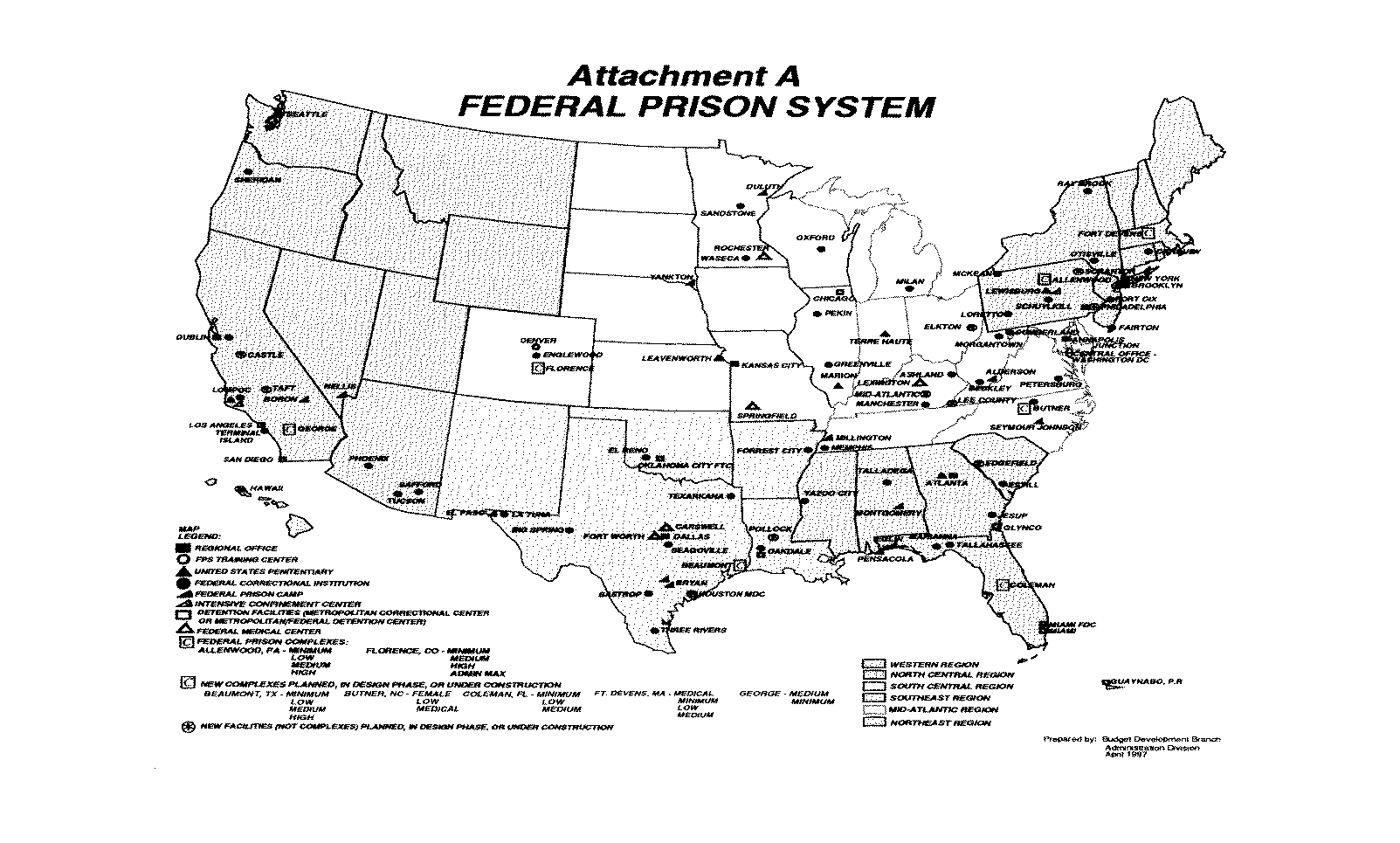
1 FPI sales include intrabureau sales of 24.5 million and excludes miscellaneous intragovernment sales of 11.7 million.
#####